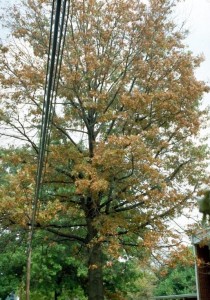
If you’re noticing a decline in your Oak trees this summer, Bacterial Leaf Scorch could be the culprit. Bacterial Leaf Scorch, discovered in New Jersey in the early 1990’s, attacks shade trees and is caused by the xylem-clogging bacteria, Xylella fastidiosa. Xylem is one of the two types of transport tissues in trees; by clogging these tissues the bacteria restricts the flow of water from the roots to the crown of the tree. This causes the tree crown to become dehydrated causing drought symptoms. The bacteria, Xylella fastidiosa, is spread by plant hoppers such as sharpshooters, treehoppers and spittlebugs.
Bacterial Leaf Scorch is a chronic disease that if left untreated will cause dieback, secondary invaders, branch death, and ultimately death.
TREES SUSCEPTIBLE TO BACTERIAL LEAF SCORCH:
Bacterial Leaf Scorch is common on pin oak and red oak, but can also affect sycamore, elm, maple, sweetgum and mulberry.
SYMPTOMS OF BACTERIAL LEAF SCORCH:
- Leaves develop normally early in the season and symptom expression begins in June and July.
- Marginal Leaf Scorch: Necrosis begins along the leaf margin and spreads toward the veins in an irregular pattern.
- Green healthy tissue is separated from the dead tissue by a yellow or reddish brown band or halo.
- Decline in vigor
- Branch dieback
- Defoliation
- Bacterial leaf scorch symptoms will reappear in the same limbs year after year and eventually spread to other limbs.
- Eventually, trees will be met with a premature death.



Bacterial Leaf Scorch Or Drought Leaf Scorch:
Bacterial Leaf Scorch is commonly mistaken for leaf scorch caused by drought. You can typically tell the difference between the two by where the symptoms take place. With Bacterial Leaf Scorch symptoms first appear on lower branches and old interior leaves. Whereas drought leaf scorch symptoms are more uniform, first appearing in upper branches and on younger leaves near the tips of branches.
Bacterial Leaf Scorch Treatment:
Unfortunately Bacterial Leaf Scorch has no cure; however, there are steps you can take to help manage and slow down the damage of the disease.
Antibiotic Injections:
Bacterial leaf scorch is typically suppressed with an antibiotic injection during spring/summer. By injecting the antibiotics, the tree’s vascular system pulls the antibiotics throughout the whole tree, suppressing the infection. Although micro-injections are a therapeutic treatment rather than a cure for Bacterial Leaf Scorch the results can be dramatic.

Tree Growth Regulator:
Tree Growth Regulator (TGR) is a great option to help slow the damage caused by Bacterial Leaf Scorch. By using a tree growth regulator you can reduce shoot growth allowing the tree to redirect some of its energy from canopy growth to defense chemicals, fibrous root production, and thicker leaf production. This helps aid in minimizing water stress, meaning less symptoms.
Mulching & Watering:
Other actions you can take to minimize water stress and dehydration is to mulch and water your tree. Mulching helps the tree retain water and deal with extreme heat and cold. Mulching properly can go a long way to minimizing water stress for trees with Bacterial Leaf Scorch. Watering frequently will also help with this. To learn how to mulch and water properly check out our blog posts on watering and mulching.
If your tree is showing signs of Bacterial Leaf Scorch don’t delay giving us a call. The earlier you intervene with treatment the better the results. To schedule an appointment with one of our Certified Arborists give us a call at 703-573-3029 or book your appointment online.


